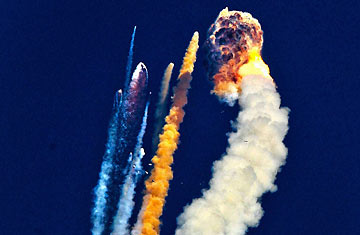
State-run Indian Space Research Organizations' (ISRO) satellite GSAT-5P rocket explodes in mid-air shortly after its launch in Sriharikota, India, Saturday, Dec. 25, 2010.
If the history of modern rocketry teaches anything, it's that sooner or later, stuff will blow up. When you pour thousands of gallons of combustible fuel into 15-story machines and then ignite the whole stack, the occasional explosion is simply going to be the cost of doing business. What you have to hope is that no one gets hurt, and if at all possible, no one's watching.
The spectacular Christmas-day explosion of India's new Geo-Synchronous Launch Vehicle (GSLV) — a gleaming 167-ft. (51m) tower of rocket — spared the country the deaths that sometimes accompany space disasters, but the public humiliation was another matter. Crowds swarmed the Satish Sahwan Space Center in Andhra Pradesh in anticipation of the launch and millions more watched live on TV as the GSLV's engines were lit at 4:04 PM. Forty-seven seconds later, engineers on the ground lost control of the vehicle. Sixteen seconds after that, they blew the haywire rocket up. A booster that was supposed to carry a critical telecommunications satellite into high-Earth orbit instead met its end just eight miles (13 km) over the Bay of Bengal.
More was lost in the GSLV disaster than a $39 million (1.75 billion rupee) rocket and its satellite payload. Also badly damaged was India's long-pursued rep as a major player in the commercial rocket game. This is not the first GSLV that has failed to fly; the booster has a record of four disasters in seven tries over the past 10 years — the most recent just last April.
"The GSLV has had only a 50% success rate," says Ajey Lele, space expert at the Institute of Defense and Security Analysis in New Delhi. "India has wanted to have the technology and the facility [to launch heavy payloads] on its own soil. Now that will not happen in the near future." But with China, Japan, the U.S. and other countries all chasing the same global business with their own fleet of rockets, the near future may be all the time the Indian program has.
India has had a big — if unheralded — presence in the space community for a long time. The Indian Space Research Organization (ISRO) — essentially India's NASA — was established in 1969 with the mission of focusing exclusively on launching communications and Earth observation satellites, programs that have immediate benefits for people on the ground and were seen as the only legitimate business a country as poor as India had in space.
ISRO did well with its limited portfolio, but things changed in 1999, when the country — puffed up after a series of successful nuclear tests the year before — decided to aim higher, planning for unmanned missions to the moon and manned missions into Earth orbit. In 2008, the Chandrayaan-1 lunar spacecraft made good on part of that promise, not only successfully orbiting the moon, but making a significant — indeed, landmark— discovery about the surprising quantity of water mixed in with the lunar soil. Meantime, the smaller predecessor of the GSLV was making a name for itself as a reliable commercial launcher, with a string of 16 successful launches against no failures. The GSLV was seen as the next logical step in a rapidly advancing program: a three-stage, heavy-lift rocket suitable for bigger payloads and crews.
But the ambitious design of the rocket may be its undoing. The problem that led to the explosion occurred in the first stage — a giant liquid-fueled engine surrounded by four, strap-on solid fuel rockets. Strap-ons, as designers know, are a great way to add oomph to a booster; the more power you need, the more solids you attach. But multiple engines mean increased complexity — not to mention the need to coordinate the exact amount of thrust each motor is producing, the exact moment ignition takes place and the tricky acoustical business of controlling vibrations. The fact that it's that stage that failed this time was not surprising but it was disappointing, since in the April launch it worked perfectly; it was the second, simpler stage that failed that time. Another former ISRO chief called the nature of this most recent accident nothing short of "a national setback."
For the moment it's unclear whether it's a setback the space agency can recover from in time. Sorting out multiple glitches in multiple stages is a time-consuming business, and even one more failure could irreparably destroy the GSLV's image. Ultimately, the global market for heavy-lift flight could simply leave India behind. Uncertain too will be the scheduled 2015 launch of the Chandrayaan II, a joint Indian-Russian moon mission that's intended to carry both a lunar satellite and a rover and was slated to be launched on a GSLV. Even less certain is the launch of the first Indian astronauts — or vyomanauts — a mission that did not yet even have a target date and is less likely than ever to get one until the big booster proves itself.
India's economic and technological growth have been extraordinary over the past ten years, but as the U.S. and Russia learned over the previous fifty, there is nothing that challenges a country's scientific and industrial base like trying to take those first steps into space. The GSLV may yet recover, and vyomanauts may yet ride it to glory, but the path won't be easy. It never, ever is. With reporting by Madhur Singh/Mumbai
